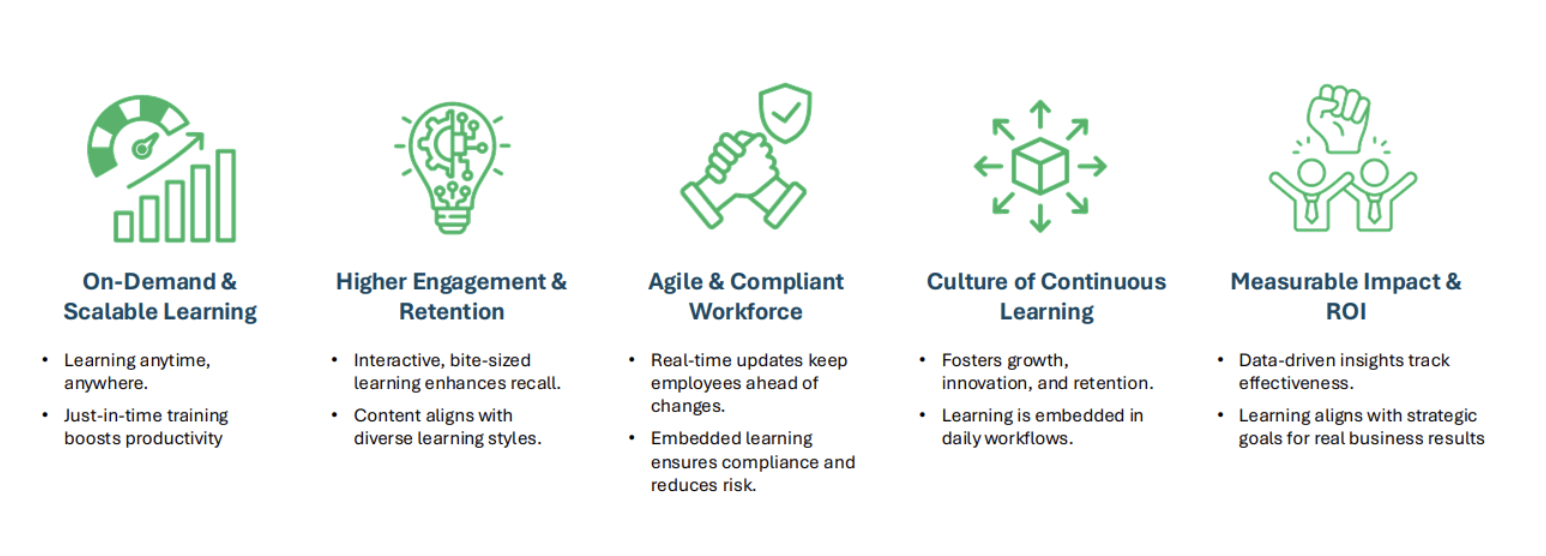You’ve spent months rolling out a new traditional learning and development programme. But a few weeks later, nothing’s changed. Employees still make the same mistakes. Teams aren’t any faster or more productive. And when you try to measure impact, the results just aren’t there.
If you’re a senior leader or L&D decision-maker, you already know traditional learning methods aren’t cutting it. Long, one-size-fits-all sessions. Content that’s outdated before it’s finished. Learning that’s disconnected from daily work—and from your business goals.
It’s frustrating. You’re investing in people but not seeing the return. Worse, the gap between what your teams know and what they need to know just keeps growing.
Here’s the good news: the problem isn’t your people. It’s the way learning is being delivered.
At Alchemy Solutions, we help organisations embed modern, agile learning practices that actually stick—so your teams stay sharp, compliant, and ready to adapt. In this article, you’ll learn why legacy L&D is holding your organisation back—and what a more effective, measurable approach looks like in practice.
What’s Broken in Traditional Learning and Development?
If your learning and development efforts feel like they’re always a step behind, it’s probably because they are.
Most traditional training models were built for a different era—where information changed slowly, people stayed in roles longer, and compliance wasn’t evolving in real-time. Today, the pace of business has changed. But your training likely hasn’t. Here’s what’s holding it back:
1. Lack of Real-World Application in Learning and Development
Training often lives in the abstract. Employees learn concepts in a classroom or online module, but struggle to apply them to their real work. Without hands-on practice, most of what’s taught never gets used—and is quickly forgotten.
2. Limited Engagement and Retention in Learning and Development
Let’s be honest: most training is boring. Long sessions with dense content don’t suit modern attention spans. Research shows that 70% of new information is forgotten within 24 hours if it’s not reinforced. If your teams aren’t engaged, they won’t retain anything.
3. When Learning and Development is Slow to Adapt
Industry regulations, customer needs, and technologies change constantly. Traditional L&D can’t keep up—it often takes months to design, approve, and roll out new material. By the time it’s live, it’s already outdated.
4. Inefficient and Costly
Flying teams in for classroom sessions or pulling people away from their jobs costs time and money. Even then, the ROI is shaky—because the impact is hard to measure and even harder to sustain.
5. Misalignment with Organisational Goals
One of the most common yet costly pitfalls in learning and development is the lack of alignment with overarching business goals. When L&D programs are designed in isolation and not connected to strategic objectives, they risk becoming tick-box exercises rather than true enablers of growth. As McKinsey highlights, effective L&D programs are those that align closely with business strategy, enhance employee performance, and support organisational goals. Without this alignment, even well-funded initiatives often fail to deliver meaningful business impact.
6. One-Size-Fits-All Learning and Development Delivery
Every learner is different, but traditional training treats them all the same. Without personalisation or flexibility, you risk wasting time on content that doesn’t connect—and doesn’t stick.
These challenges aren’t just annoying—they’re dangerous. They create knowledge gaps, slow your teams down, and put compliance at risk.
The Hidden Costs of Ignoring Learning and Development Challenges
It’s tempting to think, “Our training isn’t perfect, but it’s good enough.” The reality? Sticking with outdated learning models is quietly draining your organisation of time, money, and performance.

1. How Poor learning and developments hit productivity
When learning doesn’t happen at the point of need, teams waste time hunting down answers or waiting for formal sessions. That delay impacts delivery, slows down decision-making, and frustrates your best performers.
2. Compliance Risks Increase
In regulated industries, delays in training updates or lack of real-time learning can lead to serious compliance failures. If your people don’t have the latest information when they need it, you’re exposed to unnecessary risk.
3. Engagement Drops, Attrition Rises
People want to grow—but if they feel like their development is an afterthought, they’ll disengage. Worse, they’ll leave. Poor training doesn’t just hurt performance—it drives talent out the door.
4. Leadership Loses Visibility
Without measurable outcomes, you can’t prove what’s working and what’s not. That makes it hard to defend budgets or show how L&D contributes to growth. When training is disconnected from business goals, it becomes an easy target for cuts.
5. Innovation Slows Down
A workforce that’s always learning can adapt, solve problems, and innovate. But if your L&D isn’t evolving, neither are your people—and you risk falling behind competitors who move faster.
The real cost of legacy training isn’t just poor retention—it’s lost potential across every part of your organisation.
What a Modern Learning and Development Approach Looks Like
So, what does effective learning look like in a world that’s fast-moving, digital-first, and outcomes-driven?
A modern learning strategy isn’t about replacing the old system with another bloated programme. It’s about embedding learning into the flow of work—making it accessible, relevant, and aligned with real business outcomes.
Here’s what that looks like in practice:

1. On-Demand & Scalable Learning and Development
Training no longer needs to be scheduled weeks in advance. With on-demand access, your team can learn what they need—when they need it. Just-in-time training means less disruption, faster productivity, and learning that actually sticks.
2. Higher Engagement & Retention
Bite-sized, interactive content respects how people actually learn. It’s easier to digest, aligned with individual learning styles, and more likely to be remembered and applied in the real world.
3. Agile & Compliant Workforce
Real-time updates ensure your teams are always operating with the latest knowledge. When learning is embedded into daily routines, compliance isn’t a one-time event—it’s part of how people work.
4. Culture of Continuous Learning
Learning becomes part of your culture, not just a checkbox. It fosters innovation, builds resilience, and keeps teams ready for whatever’s next.
5. Measurable Impact & ROI
Modern L&D platforms give you real data—so you can see exactly what’s working, where skills are improving, and how learning is driving results. It makes learning a strategic asset, not a sunk cost.
This approach turns learning into a competitive advantage—one that fuels growth, drives performance, and keeps your workforce ahead of the curve.
What Changes When You Upgrade Learning and Development
Shifting from traditional training to a modern, embedded learning and development model isn’t just a theoretical win—it creates real, measurable improvements across your organisation.
Here’s what actually changes when you make the leap:
1. Teams Become Faster and More Confident
When employees have access to learning in the moment of need, they don’t second-guess decisions or wait for help. That confidence translates into faster execution, fewer mistakes, and stronger performance.
2. Compliance Gaps Close
Up-to-date knowledge becomes the norm, not the exception. Whether it’s new regulations, updated processes, or safety protocols, your people stay compliant—because the information is already at their fingertips.
3. Time to Competence Shrinks
New hires ramp up quicker. Existing staff adapt faster to change. Learning isn’t something they stop work to do—it’s something they’re doing as part of their work.
4. Managers Gain Insight and Control
With modern tools, managers can see who’s learning, what they’re learning, and how it connects to performance. That data doesn’t just prove value—it helps shape better decisions.
5. Culture Shifts from Reactive to Proactive
Learning and development isn’t a reaction to problems anymore—it’s how you prevent them. Teams become proactive, resilient, and forward-thinking, because development is constant—not occasional.
Upgrading your learning and development strategy isn’t just a box to tick. It’s a catalyst for better business outcomes.
What Are Your Next Steps?
If your learning and development strategy still relies on outdated models, you’re not just falling behind—you’re creating hidden costs across your business. From lost productivity and compliance risks to poor engagement and retention, traditional training methods simply don’t meet the needs of today’s workforce.
But it doesn’t have to be this way.
Modern learning and development is agile, embedded, and built around real business outcomes. It delivers the right knowledge at the right time—so your teams can act faster, perform better, and stay compliant without slowing down.
The question isn’t whether you can afford to change your approach. It’s whether you can afford not to. And learning and development doesn’t operate in isolation. It must support how your organisation builds long-term capability and resilience. You can explore this further in our article on Challenges in Building Organisational Capability.
Next steps? Start by asking yourself:
- Is our current training improving performance in measurable ways?
- Are our people equipped to keep pace with change?
- Can we prove the ROI of our learning and development investment?
If the answer to any of those is no—it’s time for a rethink.




